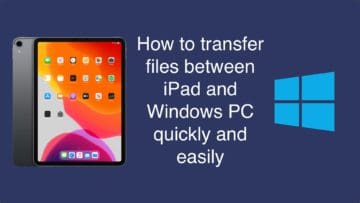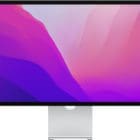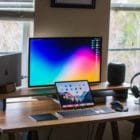The ability to transfer files between devices from different ecosystems is more important than ever. If you’re an iPad user with a Windows PC, you might think that transferring files between these two could be a complex task. However, the process is simpler than you might expect.
Related Reading
In this article, we’ll explore various methods to transfer files between your iPad and Windows PC quickly and easily. Whether you’re looking to move photos, documents, or other types of files, these straightforward solutions will ensure seamless file sharing between your devices.
Contents
Use iTunes
Before you can transfer files, ensure that you have the latest version of iTunes installed on your Windows PC.
- Download and Install iTunes: If you don’t have iTunes installed, download it from the Apple website or Microsoft Store and follow the installation prompts.
- Open iTunes: Once installed, open iTunes on your PC.
- Sign in with Your Apple ID: Use your Apple ID to log in to iTunes. This should be the same ID you use on your iPad.
After you have installed iTunes and signed in with your Apple ID, here’s what you’ll need to do next:
- Connect your iPad to your Windows PC using a USB cable. For newer iPads, you may need a USB-C to USB adapter.
- If it’s your first time connecting the iPad to the PC, you’ll need to tap “Trust” on your iPad to trust the computer.
- Your iPad should appear in iTunes. Click on the device icon near the top left of the iTunes window.
- In iTunes, click on the “File Sharing” option in the sidebar.
- Choose the app on your iPad that contains the files you want to transfer.
- Drag files from the app’s documents list to a folder or window on your PC to copy them.
It’s important to remember that you’ll need to make sure that the files you are trying to transfer are in a supported format. Additionally, we recommend keeping both your iTunes and iPad updated to the latest version for smoother functionality.
Set Up Wi-Fi Syncing
If you’re blessed with a speedy home internet connection, Wi-Fi syncing offers an alternative method for transferring files. However, to leverage this convenience, you first need to establish communication between your iPad and iTunes on Windows. Let’s dive into setting up Wi-Fi syncing:
- Connect your iPad to your Windows PC using a USB cable.
- If it doesn’t open automatically, open the iTunes app on your Windows PC.
- Select your iPad from the list of devices.
- From the main overview page, locate the Options section.
- Click the checkmark next to Sync with this iPad over Wi-Fi.
- Click the Apple button in the bottom right corner.
After you have completed the setup, your iPad should show up in the sidebar. Then, you can follow the same steps that we mentioned above for transferring files if you were physically plugging your iPad into your Windows PC.
Email Files To Yourself
Emailing files to yourself is a quick and straightforward method for transferring small files between an iPad and a Windows PC. This method is particularly useful, but there are file size limits that you’ll need to be aware of. With that in mind, here’s how you can transfer files from iPad to Windows PC using email:
- Open your preferred email app on your iPad.
- Create a new email.
- Enter your own email address in the “To” field.
- If you want, you can add a Subject, in order to make it easier to locate and identify.
- Attach the file to the email by tapping the paperclip button or Add Attachment button.
- Once the file is attached, send the email.
- On your Windows PC, open your web browser or email client and log in to the same email account you used to send the file.
- Open the email you sent from your iPad.
- Download the attached file to your desired location on your Windows PC. Usually, this involves clicking on the attachment and selecting “Download” or a similar option.
If you try uploading a file to send an email, the app will let you know if the file size is too large. Most email services have a limit on the size of attachments, typically around 25MB. If your file is larger than this, you may need to use another method, such as a cloud storage service or direct transfer.
While it’s not the most efficient method for large files or bulk transfers, it’s a reliable and universally accessible method that requires no additional software or setup beyond a basic email account.
iCloud on the Web
Apple’s cloud storage service, allows you to access and manage your files from any device with an internet connection. Thanks to continued improvements being made to the iCloud web client, you can access any files uploaded to iCloud from your Windows PC.
- Open the Files app on your iPad.
- Locate the documents or files that you want to transfer to your Windows PC.
- Long-press the file.
- From the drop-down menu that appears, tap the Move button.
- Navigate to a location within iCloud Drive.
- Tap the Copy or Move button in the top right corner.
- Wait for the file to finish being uploaded.
- Open your browser of choice on your Windows machine.
- Navigate to icloud.com.
- Sign in with the same Apple ID that is being used on your iPad.
- Click the Drive button in the app group at the top of the page.
- Navigate to the directory that you selected on your iPad.
- Locate the file that you moved.
- Hover over the file and click the three vertical dots to the right of the file name.
- From the drop-down menu, click Download a Copy…
Use an External Thumb Drive, Hard Drive, or SSD
Transferring files between an iPad and a Windows PC using an external drive is a practical solution, especially for handling large files or when you don’t have internet access. It’s important to note that you’ll want to make sure that the external drive is formatted in a file system that is compatible with both Windows and iPadOS. The most common format is FAT32, but you can also use exFAT.
- If your external drive uses USB-A and your iPad has a USB-C or Lightning port, you will need an appropriate adapter (e.g., USB-C to USB adapter, Lightning to USB 3 Camera Adapter).
- Attach the external drive to your iPad using the adapter.
- On your iPad, open the Files app.
- The external drive should appear in the sidebar under “Locations”. Tap to open it.
- Locate the files you want to transfer, then drag and drop them to your desired location on the iPad, such as “On My iPad” or a specific app’s folder.
- Safely remove the external drive from your iPad.
- Attach the external drive to your Windows PC.
- Access the external drive on your PC and move the files from the drive to your desired location on the PC.
Transfer Files Using the Cloud
Cloud services offer a convenient and efficient way to transfer files between an iPad and a Windows PC. By storing files in the cloud, you can easily access them from any device with an internet connection. Here are a few solutions that you have at your disposal when it comes to transferring files with the help of cloud services.
iCloud for Windows
iCloud for Windows bridges the divide between its own ecosystem and the world’s most popular desktop operating system. With the app installed on a PC, users can synchronize their photos, videos, mail, calendar, and other important data between their Apple devices and their Windows computer.
Thanks to updates made to the application and service in recent years, it’s a much more viable solution than it once was. If you want to learn more about using iCloud for Windows, check out our full tutorial at the link below.
Microsoft OneDrive
The next most obvious solution to transfer files between iPad and Windows PC is to use Microsoft OneDrive. This is built-in and included with every Windows device, and you can download the companion app on your iPad. Once installed, you can even access and use OneDrive right from the Files app on your iPad, removing the need to use Microsoft’s app if you would prefer to use Apple’s built-in solution.
Google Drive
The last recommendation we have when it comes to needing to transfer files between iPad and Windows PC using the cloud is Google Drive. Pretty much everyone has a Google account, and with that, you get 15GB of cloud storage for free. This is triple the amount offered by Apple’s iCloud and is accessible on pretty much all of your devices. Much like OneDrive, you can also integrate Google Drive into the iPad’s Files app for easier control when it comes to transferring your files.
You Can Use an FTP Server
Transferring files between an iPad and a Windows PC can be efficiently done using an FTP (File Transfer Protocol) server. This method is particularly useful for transferring a large number of files or large-sized files. It involves setting up an FTP server on your Windows PC and then accessing it from your iPad. Here’s how you can do it:
- First, select and install FTP server software on your Windows PC. Some popular options include FileZilla Server, WinSCP, or SolarWinds SFTP/SCP Server.
- After installation, open the FTP software and configure your server. This typically involves setting a username, password, and the server’s root directory, which will be the main folder you’ll access from your iPad.
- Once configured, start the FTP server. It will run in the background on your PC.
- To connect to the FTP server from your iPad, you’ll need your PC’s IP address. You can find it by running ‘ipconfig’ in the command prompt.
- Open the Files app on your iPad.
- Make sure that the left sidebar is expanded to show the different locations.
- In the top right corner of the sidebar, tap the three horizontal dots button.
- From the drop-down menu, select Connect to Server.
- Enter the server address that you set up from your Windows PC.
- If applicable, follow any on-screen instructions to authenticate the connection.
- Once connected, locate the files that you want to transfer.
- Long-press on the file and select Copy or Move from the drop-down menu.
- Tap the Server under the Shared section.
- Navigate to where you want the file to be saved on the server.
- Tap the Copy or Move button in the top right corner.
Using an FTP server is a powerful way to transfer files between an iPad and a Windows PC, especially when dealing with large files or bulk transfers. Although it requires a bit of setup, once you have it up and running, it provides a reliable and flexible method for file transfer.
Third-party Apps Could Help Bridge the Gap
Transferring files between an iPad and a Windows PC can be a seamless experience with the help of third-party apps. These applications bridge the gap between the two different operating systems, offering an intuitive way to move documents, photos, music, and more.
- KDE Connect: KDE Connect provides a set of features to integrate your workflow across devices, including the ability to share files and URLs to your computer from any app. You’ll also need to install the KDE Connect app on your Windows PC in order to take advantage of this service.
- Intel Unison: Provided that your Windows PC is powered by an Intel processor, you can use Intel Unison to connect and transfer files between iPad and Windows PC. The app offers quite a bit more functionality, especially for those who want to connect iPhone to Windows.
- Snapdrop: While it’s unlikely that we’ll ever see AirDrop natively supported on Windows, there is a rather useful alternative. Snapdrop offers local file sharing, right in your browser. Both your iPad and Windows PC will need to be connected to the same network, then just navigate to the website, select which files you want to transfer, and let Snapdrop handle the rest.
- AirDroid: AirDroid helps to transfer files across platforms without USB cable and mobile data cost. Millions of photos and files are shared by AirDroid users in over 150 countries everyday. AirDroid is the best productivity app for you to share photos, videos, audios or any files with your friends and across screens.
Conclusion
Transferring files between an iPad and a Windows PC doesn’t have to be a cumbersome process. As we’ve seen, there are several efficient methods to do so, each catering to different needs and preferences. From using cloud services like iCloud or Dropbox to leveraging the versatility of iTunes, or even opting for direct file transfers via USB, the options are both accessible and user-friendly.
By understanding these methods, you can effortlessly bridge the gap between your iPad and Windows PC, ensuring a smooth and hassle-free file transfer experience. This capability not only enhances your workflow but also maximizes the utility and interoperability of your devices in today’s multi-platform digital environment.
Andrew Myrick is a freelance writer based on the East Coast of the US. He enjoys everything to do with technology, including tablets, smartphones, and everything in between. Perhaps his favorite past-time is having a never-ending supply of different keyboards and gaming handhelds that end up collecting more dust than the consoles that are being emulated.










Is there any other way to transfer photos from the PC to the ipad other than itunes? itunes keeps crashing before getting to step 5. Or any news on itunes being updated?
Your advice is not correct. I’m trying to move files from my pc to my ipad. You say, open itunes on my pc and click the ipad button in the upper left corner. There is not ipad button.
I dont know for which millenium you re from but none of your blabla offers any solution. get updated dude.
Thank you so much. No more writer’s cramps and my notes. Do you have you published a book about these applications?
Thank you so much. No more writer’s cramps and my notes.